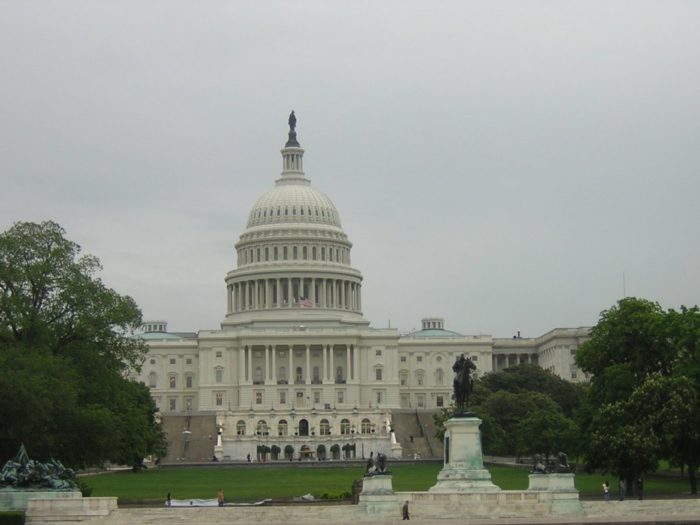
Image Credit: Lynn Underwood
One June 26th, the U.S. House of Representatives, by a mere seven votes, passed H.R. 2454, American Clean Energy and Security Act of 2009. The bill had almost 1,000 pages, and extensive changes were drawn up in a 300-page manager’s amendment!
The proposed legislation has drawn criticism from most Republicans while being sponsored and supported by Democrats. Sponsored by Henry Waxman (D) of California and Edward Markey (D) of Massachusetts, HR 2454 has further sharpened party lines, although several Republicans had previously urged passage of climate legislation, and eight actually voted for the bill. Moreover, both citizens and industry seem to generally support the concept of reducing greenhouse gas emissions and dependency on foreign oil by encouraging alternative energy sources.
The bill sets a cap on emissions of greenhouse gases, with 2006 levels being the benchmark. It aims for a 17% reduction by 2020 and 80% by 2050 using a system of permits and allowances.
In order for companies to release greenhouse gas, they must have an allowance to do so. The companies can buy and sell these allowances, which reduce over time. . .thus reaching the 80% reduction goal in 2050. But what’s in the bill? How does it affect each of us in our daily lives if it passes the Senate? What compromises are being worked out behind closed doors?
The bill creates a “National Energy Code” either by designating the International Energy Conservation Code (IECC) as the residential code OR by assigning the Department of Energy to draft a new energy code. If the IECC reaches its goal of 30% increase in residential energy efficiency over 2006 levels by 2012, it will become the standard national energy code. For it to remain the standard, it must reach 50% increased efficiency over 2006 by 2015. The DOE will have authority to pass judgment on whether (or not) the new codes reach the targeted efficiency goal. The bill legislates similar requirements for commercial construction, referencing the ASHRAE 90.1 standard.
That would seem to strongly encourage the IECC Committee and the ICC Membership to pass proposals that meet the DOE objective.
The goal of the Obama administration and congressional leadership is to pass the legislation before the U.N. Climate Conference scheduled for Copenhagen in December. The bill will likely be discussed after September, but the outcome is still very much in doubt in the Senate, with significant opposition based on the impact on states. Senate leadership believes there is insufficient support for the bill in its present state.
ICC’s vice president for federal affairs, David Karmol, says that the Senate legislation that deals with building energy efficiency is much better in respecting the current code development process, and the right of local jurisdictions to adopt and enforce its own building codes. According to Karmol, the provision in the House bill that requires the DOE to enforce a national energy code at the local level is not in the Senate legislation and is not expected to be a part of the final bill, if a bill does in fact pass in the Senate.
Weekly Newsletter
Get building science and energy efficiency advice, plus special offers, in your inbox.













4 Comments
Cap & Trade
This bill is going to place us in the poor house and place our industry in a poor position against India and China who will not pass this bill in the forseable future. With the most recent evidence provided about miss spent efforts to substatuate bogus climate recordings. It is becoming obvious that global warming is well over worked, and the earths temperature is declining.
Wishful thinking
David,
I wish you were right, David, but almost all of the evidence is against you. As you wrote your optimistic assessment, the extent of the Arctic ice cap is at a record low, and glaciers in the Alps, in Alaska, in the Himalayas, and on Kilamanjaro are shrinking at a shocking rate. What level of evidence will it take to convince skeptical Americans — the drying up of the Ganges River? Millions of Africans and Asians dying of starvation and drought?
cap and trade bill
The weather is changing due to effects we do not understand,ie the ocean waves and currents and the suns tracking and solar flares cause temperature change. please Google: Scientists opposing the global warming theroy of the left. I believe we should build high tech housing because carbon products are finate. Where did the global warming croud obtain their documented facts that substantuate their claim or facts.The goverment paid scintists(including NASA) speak the goverment line or loose their jobs. Have a good day
Global Warming
History is against global warming due to man use of hydro carbons. The Norseman left Scandinavia about 1000 AD and sought iceland but were blown off course and landed in Greenland. At the time of their landing Greenland was most habital. As time passed (1400) the summers became shorter and the winters more severe. The Norseman faded because of manny hadrships as well as cold winters. I think NASCAR and industry used dirty burning power plants back then and this brought on the blockage of the sun and made the winters excessivly cold for the Norseman.. Your Green Builder Advisor is excellent,keep up the good work and a very Merry Christmas to all.
Log in or create an account to post a comment.
Sign up Log in